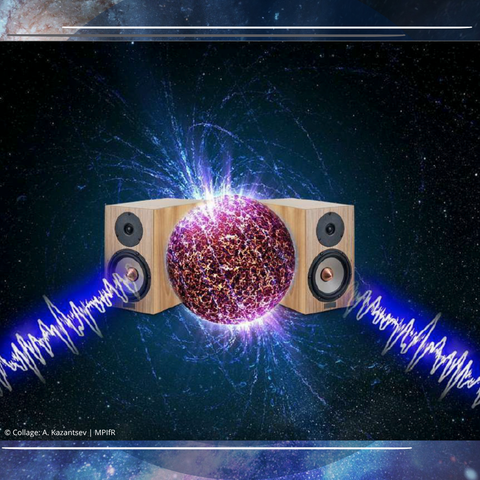First vacuum in our FAIR ring accelerator SIS100 💫
As a functionality test, one of the newly installed vacuum segments of the accelerator was successfully pumped down to high vacuum. A big step towards the completion of the SIS100! https://www.gsi.de/en/start/news/details/2025/06/12/1st-vacuum-sis100
#particleaccelerator #vacuum #science #construction
#Vacuum
Как расширенные статистики помогли раскрыть неочевидную аномалию в VACUUM PostgreSQL
Эксперт Postgres Professional Андрей Зубков «нырнул» в глубины VACUUM и выяснил, что детализированная статистика может выявить глубинные проблемы, которые критически влияют на производительность. Расскажем о том, что скрывалось в глубине PostgreSQL
https://habr.com/ru/companies/postgrespro/articles/917662/
#postgresql #postgrespro #vacuum #mvcc #freezing #vacuum_freeze #vacuum_cleaner #расширенные_статистики_VACUUM #статистики_VACUUM
Let’s do an experiment: You’ll need two hands, a pen, and a sheet of paper. Place your left hand on your chest or on your carotid artery, take the pen in your right hand, and move it steadily across the paper while recording the beats and pauses. What you create resembles an ECG – but more importantly, you’ve just converted mechanical vibrations into a digital form. These can be translated into numerical values, fed into a computer, and transformed into sound using special software. This is how the sound of your heartbeat is created.
What is sound from a physical perspective? It’s a mechanical vibration that propagates through a medium. The denser the medium, the faster sound travels: about 343 m/s in air, around 1500 m/s in water, and even faster in solids. Since space is a vacuum – the area between celestial bodies (stars, planets, etc.) is almost empty and extremely low in density – it’s impossible for sound to travel through space.
So what is “the sound of the universe”? It can best be explained using pulsars. A pulsar recording shows a series of periodic impulses (just like your heartbeat), which can be digitized and converted into sound. The peaks in the recording mark the moments when the pulsar emits radiation in the direction of the observer; the pauses represent the times when the radiation points elsewhere.
These recordings have nothing to do with the actual sounds of the objects themselves. Still, in a way, they allow us to make space audible.
©Animation & Collage: A. Kazantsev | MPIfR
#radioastronomy #research #pulsars #vacuum #experiment #universe
eufy RVC Omni E25: Automating Your Cleaning Routine The Smart Way #ankerinnovations #branded #eufy #robotvacuum #robotvacuumomnie25 #smarthome #vacuum
https://www.lowyat.net/2025/355412/eufy-rvc-omni-e25-automating-cleaning-routine-smart-way/
«Попал в Яндекс через опенсорс»: как коммиты в опенсорсные СУБД помогают развивать продукт и команду
Привет, Хабр! На связи Андрей Бородин, в Yandex Cloud я руковожу направлением разработки СУБД с открытым исходным кодом — и я попал в Яндекс через опенсорс. Я уже немного рассказывал , что и зачем мы делаем в опенсорсных БД с точки зрения облачных сервисов, где мы развиваем PostgreSQL, Greenplum, Cloudberry, Valkey и другие решения. Но из этих историй часто ускользает человеческая сторона: мы занимаемся опенсорсом не только для того, чтобы сделать решения с открытым кодом более облачными, не только потому, что это модно, но и потому, что это приносит пользу не только продукту, но и самим разработчикам‑контрибьюторам. На масштабах Яндекса возникают нетривиальные задачи, которые интересно решать. А когда мы делимся решениями с сообществом, то можем получить от них новый взгляд на проблему, и продолжить совместную разработку новой фичи в удобном формате: с кем‑то на условиях независимого сотрудничества, а кого‑то можем позвать в команду (как это было и со мной). В общем, если придерживаться опенсорс‑философии, может возникнуть ситуация win‑win. Сегодня с коллегами Леонидом Борчуком @leborchuk и Дмитрием Сарафанниковым расскажу пару историй про то, как это бывает с опенсорсными СУБД.
Water freezes fast when exposed to the #vacuum of #space but salty brine might last for an hour:
#NASA #astronomy
https://www.jpl.nasa.gov/news/lab-work-digs-into-gullies-seen-on-giant-asteroid-vesta-by-nasas-dawn/
Design Milk : This Robotic Vacuum Replenishes Its Water Tank Using Air Moisture https://design-milk.com/this-robotic-vacuum-replenishes-its-water-tank-using-air-moisture/?utm_source=rss&utm_medium=rss&utm_campaign=this-robotic-vacuum-replenishes-its-water-tank-using-air-moisture #vacuumcleaner #robotvacuum #Technology #3iTech #vacuum #Main
The stick vac and the refrigerator may sound like an awkward remark of Beauty and The Beast, but they're the places AI is going next. https://www.pickr.com.au/news/2025/home-appliances-advance-as-samsung-brings-ai-to-fridges-vacuums #appliances #home #news #ai #artificialintelligence #bixby #internetfridge #refrigerators #samsung #vacuum #vacuums
Surge in #cannabis #smuggling prompts #Thailand to tighten rules
🤦♂️"Weed #smuggled out of Thailand has reached #UK, India, Pakistan, #HongKong & many other destinat'ns, #PublicHealth Minister Thepsuthin said. Thailand will now make it harder to access cannabis except for #medical reasons.. A #legal #vacuum, w/o a #cannabislaw in place, has allowed more than 10,700 cannabis dispensaries to open nationwide.. >50 British hv been arrested in 🇹🇭 for attempted cannabis smuggling"
https://www.bangkokpost.com/thailand/general/3033366/surge-in-cannabis-smuggling-prompts-thailand-to-tighten-rules
‘c’: More Than Just Fast as We Unpack the Universe’s Master Constant
Let’s dive into the universe’s ultimate speed limit: the speed of light. It’s a concept so fundamental that it underpins much of modern physics, yet so mind-bogglingly fast that, as you say, human intuition struggles to truly grasp it. We call it ‘c’, and its value in a vacuum is precisely 299,792,458 meters per second. That’s not just an estimate; since 1983, the meter has been precisely defined as the distance that light travels in a vacuum in exactly 1/299,792,458 of a second. So, light’s speed isn’t just something we measure; it’s a foundational pillar of our measurement system.
Think about what that speed means. If you could travel at ‘c’, you could zip around the Earth’s equator about 7.5 times in a single second—literally faster than your neurons can process the act of blinking itself. This incredible velocity is why, in our everyday lives, light appears instantaneous. Flip a switch, and the room is lit. There’s no perceptible delay. But the universe is vast, and on cosmic scales, even light takes its sweet, observable time.
One of the most profound insights, largely attributable to Albert Einstein, is that ‘c’ isn’t just the speed of light; it’s the speed of causality. It’s the universe’s ultimate speed limit for any information or influence to travel. Nothing with mass can reach it, and anything massless, like photons or gluons — the force carriers of the strong nuclear force –must propagate at this speed in vacuum. However, unlike photons, gluons are confined within atomic nuclei and never observed traveling freely through empty space. This isn’t just a suggestion; it’s a fundamental rule woven into the fabric of spacetime. If you could break it, you could, in theory, send information back in time, leading to all sorts of paradoxical headaches. So, the constancy of the speed of light, regardless of the motion of the source or the observer, is a cornerstone of Special Relativity, with bizarre and beautiful consequences like time dilation and length contraction. Essentially, the universe conspires to keep ‘c’ constant for everyone, and it does so by manipulating space and time themselves.
Here’s something many people miss: the speed of light isn’t just about seeing things. It’s about interaction. When you look at the Sun, you’re seeing it as it was about 8 minutes and 20 seconds ago because that’s how long it took the light to travel the ~150 million kilometers to Earth. But it’s not just photons; any gravitational influence from the Sun also propagates at ‘c’. If, hypothetically and impossibly (since this would violate fundamental conservation laws), the Sun were to vanish instantaneously, we wouldn’t know it — either by sight or gravitational pul — for those same 8 minutes and 20 seconds. This interconnectedness, this speed limit for all fundamental forces, is what makes ‘c’ so much more than just how fast light travels. One could metaphorically think of it as the propagation speed of the universe’s fundamental interactions, akin to the operating system that governs cosmic processes.
Another layer of complexity to consider is how ‘c’ dictates our perception of “now.” When astronomers observe a galaxy billions of light-years away, they literally look billions of years into the past. The light hitting their telescopes began its journey when the universe was much younger. Telescopes become time machines. But it also means there’s no universal “now.” This reflects the profound insight known as the “relativity of simultaneity,” meaning your “now” differs fundamentally from the “now” of distant observers, such as those in the Andromeda galaxy (2.5 million light-years away), because any information exchange between you is inherently delayed by at least 2.5 million years. This fundamentally undermines the classical Newtonian concept of absolute simultaneity across the universe. Instead, we have an intricate web of cause and effect, all governed by the finite speed of light.
Perhaps one of the most subtle yet profound implications is how ‘c’ acts as a conversion factor between mass and energy in Einstein’s famous equation, E=mc². Here, ‘c²’ (the speed of light squared) is an enormous number, highlighting just how much energy is locked away in even tiny amounts of mass. This isn’t an arbitrary constant; it’s the constant that reveals the fundamental equivalence of mass and energy, reshaping human history — from nuclear power to our understanding of stellar evolution. Thus, the speed of light isn’t just a velocity; it’s a key to unlocking the deepest secrets of matter and energy.
So, while its sheer velocity is difficult to internalize, the speed of light is far more than just “fast.” It’s a fundamental constant shaping our reality, defining our ability to observe the universe, limiting the speed of all interactions, and bridging the concepts of space, time, mass, and energy. It’s the universe’s ultimate traffic cop, ensuring cosmic order is maintained. Understanding it isn’t just about comprehending a big number; it’s about appreciating the intricate and elegant rules governing the cosmos.
Okay, let’s keep unraveling the implications of this cosmic speed limit. We’ve discussed its foundational role in physics and how it governs our perception of the universe. Now, let’s bring it closer to home and then stretch our minds to the very edges of what’s knowable.
Consider the technology powering our modern world. The global positioning system (GPS) in your phone or car relies critically on the constancy and finite speed of light. GPS satellites send signals to your receiver, and by precisely timing these signals’ arrivals, your receiver calculates distances from multiple satellites, pinpointing your location. But here’s the kicker: those satellites move rapidly and exist in weaker gravitational fields than Earth’s surface. Special Relativity predicts GPS satellite clocks tick about 7 microseconds per day slower due to their speed, while General Relativity predicts clocks tick about 45 microseconds per day faster due to weaker gravity. Without accounting for these relativistic effects (a net difference of about 38 microseconds daily), GPS would accumulate significant errors within hours. Thus, every time you navigate, you’re benefiting from our understanding of ‘c’ and its deep connection to space and time.
The finite speed of light also imposes real limits on our ambitions in the digital realm and space exploration. That slight delay in video calls across continents results largely from the time signals take traveling thousands of kilometers. Similarly, supercomputer performance is increasingly limited by the “light-travel time” across microchips. When NASA communicates with Mars rovers, there’s an unavoidable delay ranging from about 3 to 22 minutes each way, dependent upon the varying orbital positions of Earth and Mars around the Sun. Mission controllers can’t “joystick” a rover in real-time; they must patiently await results after sending command sequences.
It’s also crucial to distinguish between the speed of light in a vacuum (‘c’) and its speed in other materials. When light travels through water, glass, or air, it slows due to photon interactions with atoms. While individual photons always propagate at ‘c’, their interactions with atomic structures — absorption and re-emission processes at the quantum level—result in an effectively slower average speed of the wavefront through the medium. This causes refraction, explaining phenomena like a straw appearing bent in water. The fundamental cosmic speed limit, ‘c’, always refers specifically to propagation in a vacuum.
Lastly, to reiterate a subtle point often missed: ‘c’ is the speed of all massless particles and fundamental force fields. When gravitational waves were directly detected by LIGO and Virgo in 2015 — and spectacularly corroborated with electromagnetic observations of a neutron star collision (GW170817) in 2017 — it confirmed gravitational waves indeed travel at precisely the speed of light, as Einstein predicted.
This brings us to the observable universe’s edge. Because light travels at a finite speed and the universe has a finite age (about 13.8 billion years), there’s a boundary, known as the “particle horizon,” marking the maximum distance from which light has traveled since the Big Bang. It differs subtly yet importantly from the “event horizon,” beyond which events occurring now can never become observable due to cosmic expansion. This boundary humbles us; we are surrounded by a vast, potentially infinite reality, yet can access only a finite portion, thanks entirely to the universe’s ultimate speed limit. It makes the light we do receive from distant quasars and ancient galaxies all the more precious.
#c #delay #egocentrism #einstein #fundamental #galaxy #light #speed #stars #time #universe #vacuum
I need a new vacuum mop (wet dry mop), but I can put that off for later.
Do not buy a Bissell CrossWave. They have this really, small, opening on the vacuum head. They must have known that would easily clog up with hair, because the whole vacuum head can be pulled a part. But it is all hard plastic and you, really (really), need to give it a good firm pull, which means it puts a strain on those parts over time.
#Bissell #CrossWave #Vacuum #Mop
Я нарешті зробив голосовий пакет для робота пилососа Roborock https://github.com/sverdlyuk/glados_ukr і дуже цьому радію #роботпилосос #роботпилосмок #vacuum #roborock #100дописівукраїнською @ua @rada
PostgreSQL: грабли, на которые мы наступаем… снова
СУБД PostgreSQL является одной из самых популярных реляционных баз данных с открытым исходным кодом, и благодаря почти 40-летней истории развития она является отличным выбором для приложений любого размера. Но многие начинающие администраторы и разработчики совершают одни и те же ошибки при работе с этой СУБД. В этой статье мы рассмотрим некоторые из них.
https://habr.com/ru/companies/otus/articles/902942/
#postgresql #sql #Btree_индексы #Оптимизация_производительности #индексы #Утечка_соединений #субд #Неоптимизированные_SQLзапросы #vacuum
Back to the Roots (demo) for DOS
https://youtu.be/eN1rezyDxQ8?si=L_mcFFCl0mVNj5e_
#BacktotheRoots #DOS #MSDOS #Demo #Demoscene #Wired1996 #Wired96 #vacuum
Patriots draft target Tetairoa McMillan is a vacuum receiver https://www.rawchili.com/4211041/ ##McMillan #a: #Draft #Football #FrontPage #is #NewEnglandPatriots #NewEnglandPatriotsDraft #NewEnglandPatriotsOpinionAnalysis #NewEnglandPatriots #NFL #NFLDraft #NflDraftScoutingReportProfiles #Patriots #pats #pulpit #receiver #target #tetairoa #vacuum



